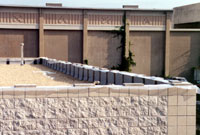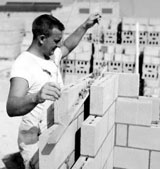Here is a simple technique that perfectly illustrates the old adage: “an ounce of prevention is worth a pound of cure.” Because masonry is site-constructed, it is susceptible to the weather while it is being built. Specifiers and designers have to write clear specifications instructing builders to cover new construction at the end of each workday. And builders need to recognize the importance of this step in ensuring weather resistant walls that look attractive.
Moisture in the Wall Cavity
Walls are meant to be barriers to weather upon completion. Good design and workmanship minimizes water penetration into the wall cavity and keeps moisture out of the building interior, but during construction, masonry is typically exposed on both sides and the top of the wall is open. Water that enters the top of the wall can saturate units and cavities. As it passes through the wall, it very likely will carry dissolved salts to the surface of the masonry, resulting in efflorescence.
What to Do
 Quite simply, water has to be kept out of the wall cavity during construction. A common method for achieving this is to cover the top of the wall with a plastic sheet at the end of the workday. The sheet should be anchored so it remains in place. In addition, the inside scaffold boards should be tilted up against the wall at the end of each day. If rain should occur, this prevents water from splashing mortar and dirt back onto the wall face. It not only keeps the face cleaner, it also keeps out excess moisture that could lead to efflorescence.
Quite simply, water has to be kept out of the wall cavity during construction. A common method for achieving this is to cover the top of the wall with a plastic sheet at the end of the workday. The sheet should be anchored so it remains in place. In addition, the inside scaffold boards should be tilted up against the wall at the end of each day. If rain should occur, this prevents water from splashing mortar and dirt back onto the wall face. It not only keeps the face cleaner, it also keeps out excess moisture that could lead to efflorescence.
 The cavities also need to be kept clean of mortar. A drainage wall will not function properly if mortar droppings are blocking the weep holes. Beveling the mortar bed away from the cavity before placing units on top of the fresh mortar minimizes doppings into the cavity. To assure unobstructed openings, some masons use a board inside the cavity to catch droppings while placing mortar and units, removing the board every few courses to empty it. Some masons and designers prefer a proprietary non-woven permanent cavity insert to catch the droppings and keep them from blocking weep holes.
The cavities also need to be kept clean of mortar. A drainage wall will not function properly if mortar droppings are blocking the weep holes. Beveling the mortar bed away from the cavity before placing units on top of the fresh mortar minimizes doppings into the cavity. To assure unobstructed openings, some masons use a board inside the cavity to catch droppings while placing mortar and units, removing the board every few courses to empty it. Some masons and designers prefer a proprietary non-woven permanent cavity insert to catch the droppings and keep them from blocking weep holes.
Related Resources
Efflorescence, IS239
Recommended Practices for Laying Concrete Block, PA043
Workmanship Part II, Imparting Quality to Masonry, IS246